The Asian American Legal Defense and Education Fund (AALDEF) is a national organization that protects and promotes the civil rights of Asian Americans through litigation, legal advocacy and community education. Founded in 1974, AALDEF focuses on critical issues affecting Asian Americans, including economic justice for workers, immigrant rights, anti-trafficking, educational equity and youth rights, voting rights and redistricting, post-9/11 civil liberties issues, housing and environmental justice, and other major civil rights issues affecting Asian American communities.
Communications Internship
Central to AALDEF’s initiatives is educating Asian Americans, policymakers, and the general public about the legal rights of Asian Americans, litigating cases that have a major impact, providing legal resources to community-based organizations, and facilitating grassroots community organizing efforts.
AALDEF’s Communications Internship offers students the opportunity to develop skills in media outreach, public policy, communications, and databasing. The internship is unpaid, but receiving academic credit for the semester is possible.
Specifically, the Communications Intern will gain hands-on experience in:
- Researching news coverage of pending policy issues or legal challenges;
- Updating a reporter database encompassing print, TV, radio, and online media;
- Tracking and archiving AALDEF media appearances;
- Researching strategic possibilities for targeting new audiences;
- Assisting with press outreach for press conferences or public events (briefings, town hall meetings, rallies, etc.); and
- Drafting press advisories and press releases (dependent on experience) and other outreach materials.
Requirements: The time commitment is 5-10 hours a week in our New York City office. Interns must commit to a minimum of 15 weeks.
To apply: Please submit the application by Tuesday, November 26, 2013. Applications will be reviewed upon receipt until the deadline. Interviewing will take place on a rolling basis. Only applicants who have been granted interviews will be notified of their advancement in the application process.
Please submit the application to:
Jennifer Weng
Spring Communications Internship
Asian American Legal Defense and Education Fund
99 Hudson Street, 12th floor
New York , New York 10013
fax: 212.966.4303
email: info@aaldef.org
For more information, contact Jennifer Weng at 212-966-5932, ext. 212 or jweng@aaldef.org.
* * * * *
AALDEF Seeks a Social Media Intern!
AALDEF’s Social Media Internship offers the opportunity to develop skills in social media, writing, advocacy, social justice, education, public policy, and media outreach.
Central to AALDEF’s initiatives is educating Asian Americans, policymakers, and the general public about our community’s legal rights, providing resources to community-based organizations, and facilitating grassroots organizing efforts.
AALDEF has an engaged and growing social media audience. The AALDEF social media intern will introduce broader audiences to civil rights and racial justice issues daily. For a small time commitment, the AALDEF social media intern will gain exposure to social justice advocacy, journalism, and progressive communications, and work with an inspiring group of progressive thinkers.
The ideal candidate is an avid news readers, well-versed in current events (from politics to pop culture), creative, committed to AALDEF’s mission, and experienced using social media including Facebook, Tumblr, and Twitter.
The internship is unpaid, but receiving academic credit for the semester is possible for students.
Requirements: The time commitment is relatively small (5-10 hours a week). We are looking for a commitment of six months but can be flexible on duration. This is a remote position that can be done from any location.
To apply: Interested applicants should send a resume and cover letter, and anyTwitter account(s) you use; any Facebook pages you’ve had the opportunity to run for schools, publications, companies, etc.; and/or any Tumblr(s) or blogs.
Please submit the application by Tuesday, November 26, 2013. Applications will be reviewed upon receipt until the deadline. Interviews will take place on a rolling basis. Only applicants who have been granted interviews will be notified of their advancement in the application process. Please submit the application to:
Jennifer Weng
Subject: AALDEF Social Media Internship
Email: info@aaldef.org
For more information, contact Jennifer Weng at 212-966-5932, ext. 212 or jweng@aaldef.org.
* * * * *
Special Events Internship
The position will involve in the planning, preparation and execution of our 40th anniversary dinner gala and silent auction in March 2014.
Responsibilities include but are not limited to:
- Assisting with sponsorship development and outreach, writing materials, managing and following up on reservations, ticket sales, and donations.
- Maintaining databases and files.
- Preparing and maintaining sponsor/donor solicitations and acknowledgments, mailings, and emails.
- Assisting with the production of the invitations and dinner programs.
- Coordinating silent auction/raffle donations, including developing prospects, solicitations and acknowledgment, brochure and silent auction planning, and production.
- Meeting event deadlines.
Applicants must be self-motivated, have good organizational and writing skills, be detail oriented, able to work independently, organize and coordinate multiple tasks, develop and manage projects in a timely manner, and have database and internet skills. Some fundraising experience is preferable. Knowledge of Microsoft Word and Excel required. Experience using Filemaker is a plus. Flexibility with extra hours around the time of special events is necessary. Undergraduate students only. Workstudy grants accepted.
How to Apply: Candidates should submit a cover letter and resume by Tuesday, November 26, 2013. Please send to:
Jennifer Weng
Asian American Legal Defense and Education Fund
99 Hudson Street, 12 fl, New York, NY 10013-2815
Or Email to: jweng@aaldef.org (write “Special Events Internship” in the subject line)






